外研版(2019)选择性必修 第二册Unit 5 A delicate world Using language(2)课件(共12张PPT)
文档属性
| 名称 | 外研版(2019)选择性必修 第二册Unit 5 A delicate world Using language(2)课件(共12张PPT) |  | |
| 格式 | pptx | ||
| 文件大小 | 7.2MB | ||
| 资源类型 | 教案 | ||
| 版本资源 | 外研版(2019) | ||
| 科目 | 英语 | ||
| 更新时间 | 2024-04-29 15:07:01 | ||
图片预览

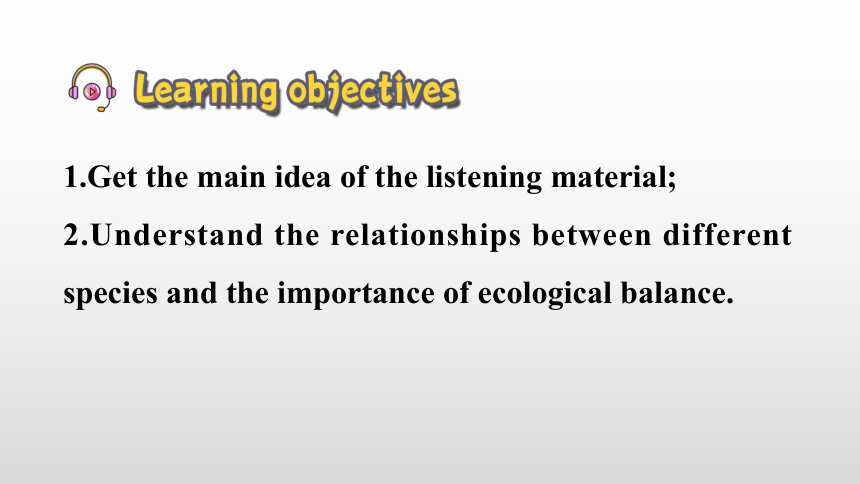
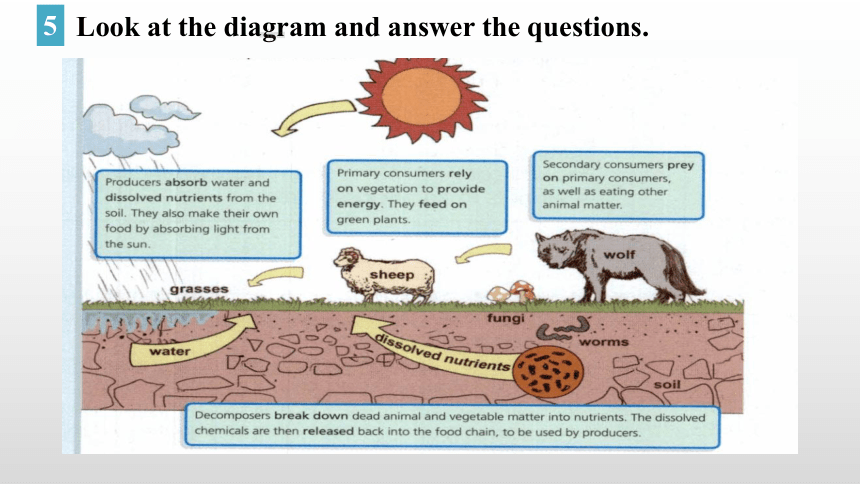
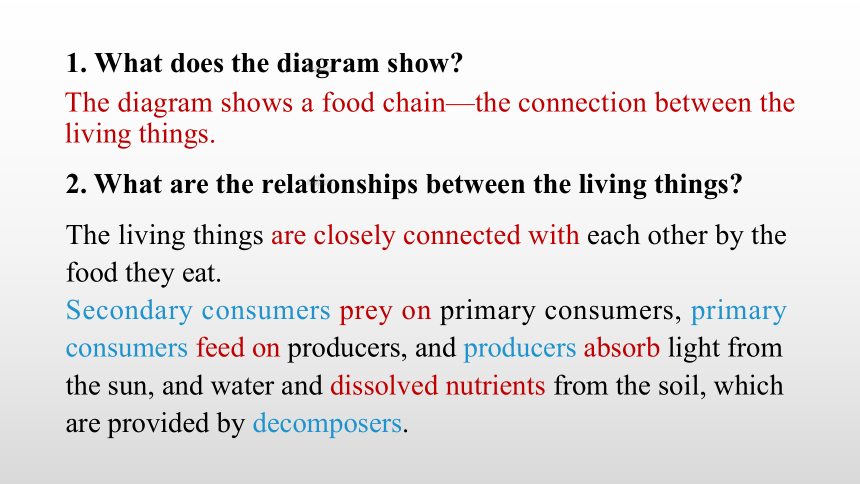
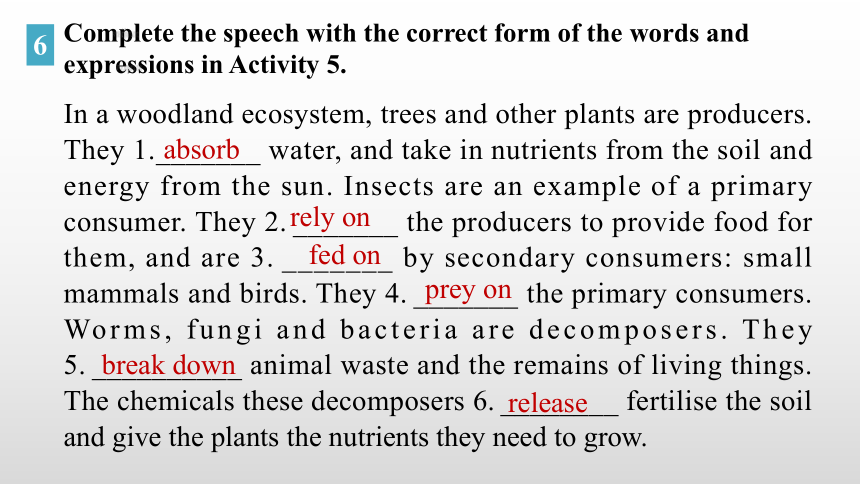
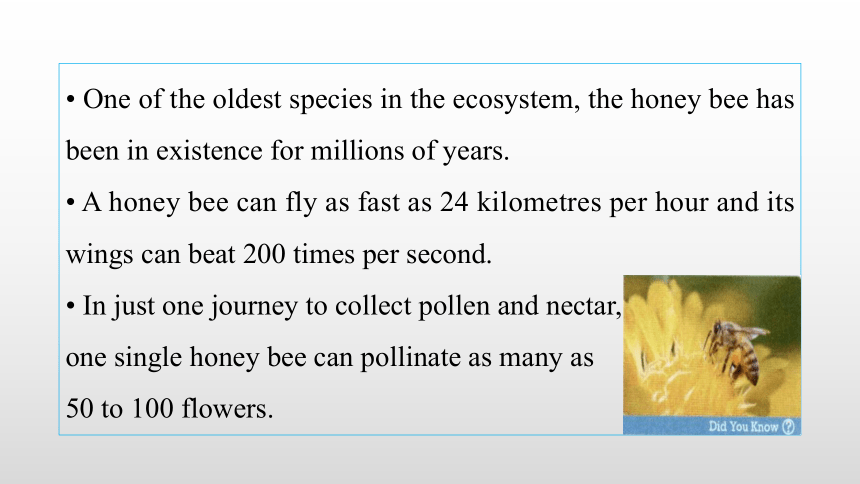
文档简介
(共12张PPT)
Using language(2)—
Listening and Speaking
1.Get the main idea of the listening material;
2.Understand the relationships between different species and the importance of ecological balance.
Look at the diagram and answer the questions.
5
1. What does the diagram show
2. What are the relationships between the living things
The diagram shows a food chain—the connection between the living things.
The living things are closely connected with each other by the food they eat.
Secondary consumers prey on primary consumers, primary consumers feed on producers, and producers absorb light from the sun, and water and dissolved nutrients from the soil, which are provided by decomposers.
In a woodland ecosystem, trees and other plants are producers. They 1._______ water, and take in nutrients from the soil and energy from the sun. Insects are an example of a primary consumer. They 2. _______ the producers to provide food for them, and are 3. _______ by secondary consumers: small mammals and birds. They 4. _______ the primary consumers. Worms, fungi and bacteria are decomposers. They
5. __________ animal waste and the remains of living things. The chemicals these decomposers 6. ________ fertilise the soil and give the plants the nutrients they need to grow.
absorb
rely on
fed on
prey on
break down
release
6
Complete the speech with the correct form of the words and expressions in Activity 5.
One of the oldest species in the ecosystem, the honey bee has been in existence for millions of years.
A honey bee can fly as fast as 24 kilometres per hour and its wings can beat 200 times per second.
In just one journey to collect pollen and nectar,
one single honey bee can pollinate as many as
50 to 100 flowers.
7
Listen to the conversation and choose the true statements.
1 Bees are very important to our food supply because they provide honey.
2 The bee population is declining.
3 Without bees, humans would die out.
4 All human crops depend on bees for pollination.
5 If bees became extinct, other insects could pollinate enough crops.
6 Humans are responsible for the decline in the bee population.
√
√
√
8
Listen again and complete the flow chart.
A combination of things damages bee habitats, mainly 1.____________________________.
pesticides and climate change
The bee population is 2.______________________. According to statistics, bee numbers in the US 3.___________________ in just one year.
declining very quickly
have fallen by 17%
Without bees, crops would 4.___________________.
5._____________ would not be able to compensate for the loss of bees, because 6.__________________________________________of the species of crops.
be unable to reproduce
Other insects
bees are responsible for pollinating about 70%
Animals that live on the crops 7._______________.
Humans have nothing to eat and die out.
would die out
Expressing doubt Responding to doubt
You must be kidding! Are you sure about...
I don’t believe it! Check it out for yourself...
It’s a fact! According to statistics...
Don’t forget that…
You must be kidding!
I don’t believe it!
Are you sure about ...
It’s a fact!
Don’t forget that…
Check it out for yourself... According to statistics...
9
Complete the boxes with the expressions from the conversation.
Meg: Hey Ollie, have you heard that the bee population is declining
Ollie: No, I haven’t. But, thinking about it, I hardly ever see bees these days. When I was little, they seemed to be everywhere!
Meg: If bees die out, humans will die out too.
Ollie: What ! You must be kidding! I don’t believe it!
Meg: It’s a fact!! I watched a nature documentary all about it the other evening. Bees are very important to our food supply.
Ollie: How can that be possible Humans won’t die out just because there’s no honey!
Meg: Bees don’t just make honey. Don’t forget that bees are also responsible for pollinating plants. Without them, crops would be unable to reproduce.
Ollie: But surely there are other ways of getting these crops to reproduce. Does it have to be bees
Meg: Well, there are other insects that pollinate plants, but it’s unlikely that they would be able to fully compensate for the loss of bees. Bees are responsible for pollinating about 70% of the species of crops.
Listening materials
Ollie: Are you sure about that data It sounds rather exaggerated.
Meg: Watch the documentary and check it out for yourself if you don’t believe me. Without bees, numerous plant species would die out. Animals that live on the crops would die out, and we wouldn’t have enough to eat.
Ollie: Seriously That’s scary! But looking on the bright side, there are millions and millions of bees. They’re not going to die out any time soon.
Meg: I’m afraid you’re wrong. The bee population is declining very quickly. According to statistics, bee numbers in the US have fallen by 17% in just one year.
Ollie: Gosh! What caused that
Meg: A combination of things, really, but it’s mainly due to damage to their habitats caused by pesticides and climate change.
Ollie: So human activity is the main cause
Meg: That’s right.
Ollie: Well, in that case, we’d better do something before it’s too late.
Work in pairs. Talk about what would happen to the ecosystem if another species died out. Use the words and expressions in this section.
10
Using language(2)—
Listening and Speaking
1.Get the main idea of the listening material;
2.Understand the relationships between different species and the importance of ecological balance.
Look at the diagram and answer the questions.
5
1. What does the diagram show
2. What are the relationships between the living things
The diagram shows a food chain—the connection between the living things.
The living things are closely connected with each other by the food they eat.
Secondary consumers prey on primary consumers, primary consumers feed on producers, and producers absorb light from the sun, and water and dissolved nutrients from the soil, which are provided by decomposers.
In a woodland ecosystem, trees and other plants are producers. They 1._______ water, and take in nutrients from the soil and energy from the sun. Insects are an example of a primary consumer. They 2. _______ the producers to provide food for them, and are 3. _______ by secondary consumers: small mammals and birds. They 4. _______ the primary consumers. Worms, fungi and bacteria are decomposers. They
5. __________ animal waste and the remains of living things. The chemicals these decomposers 6. ________ fertilise the soil and give the plants the nutrients they need to grow.
absorb
rely on
fed on
prey on
break down
release
6
Complete the speech with the correct form of the words and expressions in Activity 5.
One of the oldest species in the ecosystem, the honey bee has been in existence for millions of years.
A honey bee can fly as fast as 24 kilometres per hour and its wings can beat 200 times per second.
In just one journey to collect pollen and nectar,
one single honey bee can pollinate as many as
50 to 100 flowers.
7
Listen to the conversation and choose the true statements.
1 Bees are very important to our food supply because they provide honey.
2 The bee population is declining.
3 Without bees, humans would die out.
4 All human crops depend on bees for pollination.
5 If bees became extinct, other insects could pollinate enough crops.
6 Humans are responsible for the decline in the bee population.
√
√
√
8
Listen again and complete the flow chart.
A combination of things damages bee habitats, mainly 1.____________________________.
pesticides and climate change
The bee population is 2.______________________. According to statistics, bee numbers in the US 3.___________________ in just one year.
declining very quickly
have fallen by 17%
Without bees, crops would 4.___________________.
5._____________ would not be able to compensate for the loss of bees, because 6.__________________________________________of the species of crops.
be unable to reproduce
Other insects
bees are responsible for pollinating about 70%
Animals that live on the crops 7._______________.
Humans have nothing to eat and die out.
would die out
Expressing doubt Responding to doubt
You must be kidding! Are you sure about...
I don’t believe it! Check it out for yourself...
It’s a fact! According to statistics...
Don’t forget that…
You must be kidding!
I don’t believe it!
Are you sure about ...
It’s a fact!
Don’t forget that…
Check it out for yourself... According to statistics...
9
Complete the boxes with the expressions from the conversation.
Meg: Hey Ollie, have you heard that the bee population is declining
Ollie: No, I haven’t. But, thinking about it, I hardly ever see bees these days. When I was little, they seemed to be everywhere!
Meg: If bees die out, humans will die out too.
Ollie: What ! You must be kidding! I don’t believe it!
Meg: It’s a fact!! I watched a nature documentary all about it the other evening. Bees are very important to our food supply.
Ollie: How can that be possible Humans won’t die out just because there’s no honey!
Meg: Bees don’t just make honey. Don’t forget that bees are also responsible for pollinating plants. Without them, crops would be unable to reproduce.
Ollie: But surely there are other ways of getting these crops to reproduce. Does it have to be bees
Meg: Well, there are other insects that pollinate plants, but it’s unlikely that they would be able to fully compensate for the loss of bees. Bees are responsible for pollinating about 70% of the species of crops.
Listening materials
Ollie: Are you sure about that data It sounds rather exaggerated.
Meg: Watch the documentary and check it out for yourself if you don’t believe me. Without bees, numerous plant species would die out. Animals that live on the crops would die out, and we wouldn’t have enough to eat.
Ollie: Seriously That’s scary! But looking on the bright side, there are millions and millions of bees. They’re not going to die out any time soon.
Meg: I’m afraid you’re wrong. The bee population is declining very quickly. According to statistics, bee numbers in the US have fallen by 17% in just one year.
Ollie: Gosh! What caused that
Meg: A combination of things, really, but it’s mainly due to damage to their habitats caused by pesticides and climate change.
Ollie: So human activity is the main cause
Meg: That’s right.
Ollie: Well, in that case, we’d better do something before it’s too late.
Work in pairs. Talk about what would happen to the ecosystem if another species died out. Use the words and expressions in this section.
10
